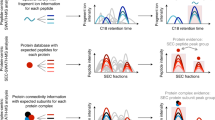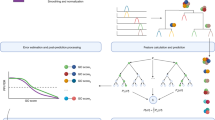Abstract
In living cells, most proteins are organized in stable or transient functional assemblies, protein complexes, which control a multitude of vital cellular processes such as cell cycle progression, metabolism, and signal transduction. Over several decades, specific protein complexes have been analyzed by structural biology methods, initially X-ray crystallography and more recently single particle cryoEM. In parallel, mass spectrometry (MS)-based methods including in vitro affinity-purification coupled to MS or in vivo protein proximity-dependent labeling methods have proven particularly effective to detect complexes, thus nominating new assemblies for structural analysis. Those approaches, however, are either of limited in throughput or require specifically engineered protein systems.
In this chapter, we present protocols for a workflow that supports the parallel analysis of multiple complexes from the same biological sample with respect to abundance, subunit composition, and stoichiometry. It consists of the separation of native complexes by size-exclusion chromatography (SEC) and the subsequent mass spectrometric analysis of the proteins in consecutive SEC fractions. In particular, we describe (1) optimized conditions to achieve native protein complex separation by SEC, (2) the preparation of the SEC fractions for MS analysis, (3) the acquisition of the MS data at high throughput via SWATH/DIA (data-independent analysis) mass spectrometry and short chromatographic gradients, and (4) a set of bioinformatic tools for the targeted analysis of protein complexes. Altogether, the parallel measurement of a high number of complexes from a single biological sample results in unprecedented system-level insights into the remodeling of cellular protein complexes in response to perturbations of a broad range of cellular systems.
Access this chapter
Tax calculation will be finalised at checkout
Purchases are for personal use only
Similar content being viewed by others
References
Ganem B, Li YT, Henion JD (1991) Observation of noncovalent enzyme substrate and enzyme product complexes by ion-spray mass-spectrometry. J Am Chem Soc 113(20):7818–7819
Savitski MM et al (2014) Tracking cancer drugs in living cells by thermal profiling of the proteome. Science 346(6205):1255784
Rappsilber J et al (2000) A generic strategy to analyze the spatial organization of multi-protein complexes by cross-linking and mass spectrometry. Anal Chem 72(2):267–275
Zhang Z, Smith DL (1993) Determination of amide hydrogen exchange by mass spectrometry: a new tool for protein structure elucidation. Protein Sci 2(4):522–531
Feng Y et al (2014) Global analysis of protein structural changes in complex proteomes. Nat Biotechnol 32(10):1036–1044
Leitner A (2016) Cross-linking and other structural proteomics techniques: how chemistry is enabling mass spectrometry applications in structural biology. Chem Sci 7(8):4792–4803
Gavin AC et al (2006) Proteome survey reveals modularity of the yeast cell machinery. Nature 440(7084):631–636
Roux KJ et al (2012) A promiscuous biotin ligase fusion protein identifies proximal and interacting proteins in mammalian cells. J Cell Biol 196(6):801–810
Porath J, Flodin P (1959) Gel filtration—method for desalting and group separation. Nature 183(4676):1657–1659
Ramani AK et al (2008) A map of human protein interactions derived from co-expression of human mRNAs and their orthologs. Mol Syst Biol 4:180
Wessels HJCT et al (2009) LC-MS/MS as an alternative for SDS-PAGE in blue native analysis of protein complexes. Proteomics 9(17):4221–4228
Andersen JS et al (2003) Proteomic characterization of the human centrosome by protein correlation profiling. Nature 426(6966):570–574
Glatter T et al (2009) An integrated workflow for charting the human interaction proteome: insights into the PP2A system. Mol Syst Biol 5:237
Hauri S et al (2016) A high-density map for navigating the human Polycomb Complexome. Cell Rep 17(2):583–595
Hauri S et al (2013) Interaction proteome of human hippo signaling: modular control of the co-activator YAP1. Mol Syst Biol 9:713
Huttlin EL et al (2015) The BioPlex network: a systematic exploration of the human Interactome. Cell 162(2):425–440
Choi H et al (2011) SAINT: probabilistic scoring of affinity purification-mass spectrometry data. Nat Methods 8(1):70–73
Scott NE et al (2017) Interactome disassembly during apoptosis occurs independent of caspase cleavage. Mol Syst Biol 13(1):906
Havugimana PC et al (2012) A census of human soluble protein complexes. Cell 150(5):1068–1081
Heusel M et al (2019) Complex-centric proteome profiling by SEC-SWATH-MS. Mol Syst Biol 15(1):e8438
Heusel M et al (2020) A global screen for assembly state changes of the mitotic proteome by SEC-SWATH-MS. Cell Syst 10(2):133–155.e6
Bache N et al (2018) A novel LC system embeds Analytes in pre-formed gradients for rapid, ultra-robust proteomics. Mol Cell Proteomics 17(11):2284–2296
Gillet LC et al (2012) Targeted data extraction of the MS/MS spectra generated by data-independent acquisition: a new concept for consistent and accurate proteome analysis. Mol Cell Proteomics 11(6):p. O111 016717
Collins BC et al (2017) Multi-laboratory assessment of reproducibility, qualitative and quantitative performance of SWATH-mass spectrometry. Nat Commun 8:291
Perez-Riverol Y et al (2019) The PRIDE database and related tools and resources in 2019: improving support for quantification data. Nucleic Acids Res 47(D1):D442–D450
Escher C et al (2012) Using iRT, a normalized retention time for more targeted measurement of peptides. Proteomics 12(8):1111–1121
Li X et al (2015) Proteomic analyses reveal distinct chromatin-associated and soluble transcription factor complexes. Mol Syst Biol 11(1):775
Rost HL et al (2014) OpenSWATH enables automated, targeted analysis of data-independent acquisition MS data. Nat Biotechnol 32(3):219–223
Rost HL et al (2016) TRIC: an automated alignment strategy for reproducible protein quantification in targeted proteomics. Nat Methods 13(9):777–783
Rost HL, Aebersold R, Schubert OT (2017) Automated SWATH data analysis using targeted extraction of ion chromatograms. Methods Mol Biol 1550:289–307
Ludwig C et al (2018) Data-independent acquisition-based SWATH-MS for quantitative proteomics: a tutorial. Mol Syst Biol 14(8):e8126
Rosenberger G et al (2017) Statistical control of peptide and protein error rates in large-scale targeted data-independent acquisition analyses. Nat Methods 14(9):921
Mallam AL et al (2019) Systematic discovery of endogenous human ribonucleoprotein complexes. Cell Rep 29(5):1351
Gilbert M, Schulze WX (2019) Global identification of protein complexes within the membrane proteome of Arabidopsis roots using a SEC-MS approach. J Proteome Res 18(1):107–119
Crozier TWM et al (2017) Prediction of protein complexes in Trypanosoma brucei by protein correlation profiling mass spectrometry and machine learning. Mol Cell Proteomics 16(12):2254–2267
Bruderer R et al (2015) Extending the limits of quantitative proteome profiling with data-independent acquisition and application to acetaminophen-treated three-dimensional liver microtissues. Mol Cell Proteomics 14(5):1400–1410
Tsou CC et al (2015) DIA-umpire: comprehensive computational framework for data-independent acquisition proteomics. Nat Methods 12(3):258–264, 7 p following 264
Schubert OT et al (2015) Building high-quality assay libraries for targeted analysis of SWATH MS data. Nat Protoc 10(3):426–441
Rosenberger G et al (2014) A repository of assays to quantify 10,000 human proteins by SWATH-MS. Sci Data 1:140031
Acknowledgments
Contributions: AF, FF, and FU conceived and designed the project. MV and FF prepared and conducted the showcase experiment. AF and FF analyzed the showcase example. AF, FF, FU, and CM wrote the manuscript. BC, LG, MG, and RA supervised, reviewed, and edited the manuscript. MG and RA provided funding and resources to support the project. Fig. 1 was created with BioRender.com.
Declaration of Interests: The authors declare no conflict of interest.
Author information
Authors and Affiliations
Corresponding author
Editor information
Editors and Affiliations
Rights and permissions
Copyright information
© 2021 Springer Science+Business Media, LLC, part of Springer Nature
About this protocol
Cite this protocol
Fossati, A. et al. (2021). System-Wide Profiling of Protein Complexes Via Size Exclusion Chromatography–Mass Spectrometry (SEC–MS). In: Carrera, M., Mateos, J. (eds) Shotgun Proteomics. Methods in Molecular Biology, vol 2259. Humana, New York, NY. https://doi.org/10.1007/978-1-0716-1178-4_18
Download citation
DOI: https://doi.org/10.1007/978-1-0716-1178-4_18
Published:
Publisher Name: Humana, New York, NY
Print ISBN: 978-1-0716-1177-7
Online ISBN: 978-1-0716-1178-4
eBook Packages: Springer Protocols




